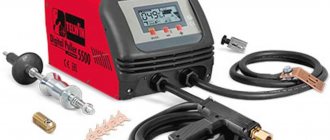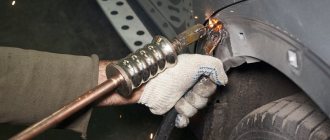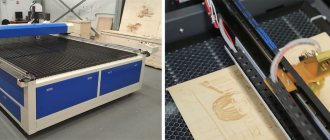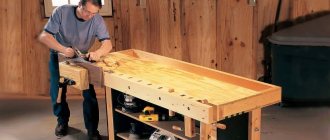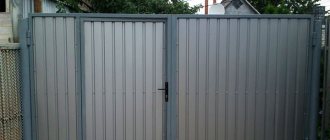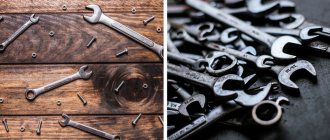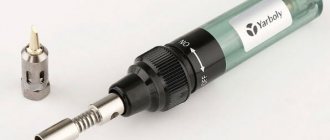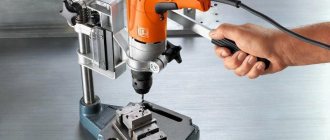A well-equipped locksmith workplace by default implies the presence of a workbench. There are many different models and among them you need to choose the most suitable option for your specific conditions. So, how do the models on the market differ and what are their advantages?
An equipped workplace is necessary for everyone who is engaged in metal processing at an amateur level or professionally. Regardless of the frequency of use, the equipment must be functional, reliable and durable. A metalworking workbench best suits the stated requirements. It is indispensable in all cases where metal processing is planned.
A metal workbench is a specialized table designed for performing metal work. An experienced specialist, of course, has a clear idea of what a locksmith’s workbench should ideally be like. Next, we will consider the equipment options produced today, their features and advantages. Let's figure out which of the existing models is more suitable for professional use and which one is more suitable for amateur use.
Workbench requirements
A master professionally engaged in metalworking does his work only in a specially equipped place. Comfortable conditions and safety will be ensured only if there is a workbench. And, according to practicing experts, it must meet a number of requirements:
- large margin of safety and reliability. It is important that you can work in intensive mode or with large, heavy workpieces;
- maximum functionality and thoughtful ergonomics. A well-organized workplace, where everything necessary for work is always at hand, is a prerequisite for production efficiency;
- sustainability. When you have to work with heavy components, this requirement is mandatory for safety. Without a stable table it is impossible to ensure high accuracy of work;
- immunity to aggressive compounds and other influences. A bench made from high-quality materials lasts for several decades.
Workplace organization
The average garage doesn't have a lot of free space. In addition to compactness, the criterion that influences the parameters of a desktop is the amount of work to which you are going to devote your time. If you expect that you will not only drill and hammer nails, but also do more complex manipulations, you should think about a larger table. It is more convenient to carry out periodic processing of parts or workpieces if the vice and the sharpening or drilling machine are in assembled condition. The garage owner will have to find a solution for several more problems:
Read also: Sharpen a meat grinder knife with your own hands
Storage
. Due to limited space, the workbench has another important task - providing convenient storage conditions. The right workbench is used not only as a work desk, but also as a convenient container for consumables, spare parts and tools.
When everything is at hand
Selecting a location
. A specific garage task is choosing a place for a workbench. Two conditions must be met. Firstly, the distance between the car and the workbench and shelves in the garage must be at least one meter. The second condition is that you must be comfortable working near the machine without the risk of damaging it.
Electrical connections
. Electrification must be safe, taking into account the influence of dampness and aggressive liquids common in garage work. Electrical wiring must be laid in fireproof corrugation or hidden in grooves. If your electrical panel has a metal casing, it must be grounded.
The car should not be a hindrance
Lighting
. Considering that there are always shadow areas in the garage (from the car, shelves and racks), a combined system of several light sources designed for different tasks would be a practical option. Above the workbench, in the work area, it is convenient to install a bright turning lamp, protected by a lampshade. The lamp can be made removable; It is also convenient to build it into a workbench, rather than fixing it on the wall - if you want to move the table, there will be no problems with electrification.
This might be interesting!
In the article at the following link, read about the interior decoration of the garage.
Design and purpose of a metalworking workbench
In order for a workbench to be truly reliable, durable and practical, its design needs to be worked out in detail. The supporting frame is made of steel. The tabletop is cut out of dense MDF 30 millimeters thick and covered with galvanized iron on top. Such a surface perfectly tolerates any load - dynamic and static. Hammer blows, welding splashes - all this will not affect such a tabletop in any way.
Spilled oil, solvent, gasoline and other mildly aggressive compounds do not react with countertop materials. In addition, the materials do not require any special care - only cleaning the workplace upon completion of a certain stage of work. To enhance the protective properties of the surface, it is recommended to apply powder paint.
It is desirable that the tabletop have edges around the perimeter. Then it will be easier to work with small parts that will not fly off the table. It’s good if the package includes a perforated screen. In this case, there will be a place for attaching the necessary tools - a hammer, a hacksaw, a screwdriver, pliers and various devices. Even more convenience in terms of storing available materials and tools is provided by drawers, cabinets, and shelves.
Depending on the specifics of the work, the lower part of the workbench may differ radically from the upper. The configuration can be highly specialized and intended to perform specific tasks. The shelf and drawers are made with a load capacity of up to 35 kilograms. Sections intended for storing official documentation are equipped with built-in locks and can be locked with a key.
The functionality of a workbench is directly related to its configuration. In production and large workshops, it is very important to have a large assortment of various types of devices and accessories in order to perform a wide range of metal processing operations. In most cases, a home craftsman gets by with a minimal set of tools and equipment. The main list of works that will require a workbench:
- marking metal blanks;
- bending and cutting;
- drilling;
- restoration or cutting of new threads;
- riveting;
- engraving;
- wiping, grinding and polishing the surface.
If we talk about metalworking equipment, the most popular is a vice. They can be made stationary - securely screwed to the surface or removable. In the latter case, the mechanism must ensure quick and reliable fixation of the bench vice to the table top.
Selection criteria: wood or metal
For many car enthusiasts, the garage is a second home, so they approach its arrangement with due attention. A particularly important point is the purchase of a workbench; the selection criterion may be the purpose for which it is intended. In most cases, such equipment is installed to perform the following work:
For regular inspection and maintenance
car.
For small plumbing work
, minor repairs, correction of defects associated with the maintenance of the house and garden area.
If plumbing or carpentry is part of your hobby
.
The first question that arises when choosing is the material of manufacture. There are wooden (most often homemade) and metal workbenches offered by various manufacturers, both domestic and foreign.
Workplace for the soul
Wooden workbenches
A wooden workbench for the garage, made entirely or partially from wood, is suitable for periodic and short-term work with simple parts; it is not well suited for machining complex metal components. The frame of such models is made of strong wood (beech or oak) and secured with self-tapping screws. The stability of the table is ensured by additional spacers, transverse or x-shaped. Wooden models are usually equipped with shelves or drawers for storage. The wooden tabletop is trimmed with metal along the edge.
A common model is a design of two massive cabinets connected by a tabletop. This option looks quite practical, since it solves most of the problems associated with the placement of tools. Despite the relative cheapness and good (albeit somewhat limited) functionality, many believe that a workbench in a wooden garage has significant disadvantages:
The wooden bench is not designed for heavy loads
.
With intensive use
The service life of the frame is significantly
reduced
.
On our website you can find contacts of construction companies that offer metal structure installation services. You can communicate directly with representatives by visiting the “Low-Rise Country” exhibition of houses.
The table area does not allow for placing
several types of equipment at the same time.
becomes unusable over time under the influence of chemical agents (paints, solvents) and metal dust.
, and traces of oils remain forever.
Wood is a fire hazardous material
; in combination with the collection of chemical substances located nearby, this property increases many times over.
Metal workbenches
To assemble a functional metal bench, you will need special equipment and skills in working with metal (the fragments are connected by welding). Metal models, assembled in workshop conditions, have a durable construction and modern design. Despite the higher price due to the cost of metal and a more complex assembly process, metal equipment has many advantages, including:
Long service life
. Stainless steel models boast an impeccable service life of 50 years.
Large selection of models
and their configurations. Manufacturers offer both universal and highly specialized options.
Multifunctionality
. You can perform any type of work, including turning, cutting, grinding.
Mobility and compactness
. Many models can be disassembled (in whole or in part), and, if necessary, new tools (vises, clamps) can be added.
Light weight
while maintaining strength. The tabletop is resistant to deformation and damage (scratches).
Minimal care
. The design is characterized by increased resistance to corrosion processes and does not require painting. Cleaning metal dust and shavings from the surface of the countertop does not take much time.
Workbench dimensions
The standard size of a single workbench is considered to be 80 cm wide and 150 cm long. These are the optimal dimensions of the working surface for one specialist. The length of multi-person workbenches can be different and reach 3.5 meters. This solution is used when it is necessary to combine the efforts of two or more specialists who will work together on one task.
Ideally, the height of the table is selected according to the height of the master. If we talk about statistical data, then the average height of an employee is approximately 170-180 cm. For him, the optimal location of the table is considered to be 70-90 cm from the base. The main thing is that the specialist does not have to bend over and slouch during the work process.
In the case of individual selection, the best option is to place the tabletop at the height of the palm of a standing employee. In this case, his arms should be straight down, and the palm itself should be horizontal. As statistics show, the standard workbench height is 75-80 centimeters. These days, there are models of tables with adjustable legs on the market. Retractable supports allow you to choose the optimal height of the workplace. The adjustment range is 5-25 centimeters.
Mobile structures occupy a special place. Wheels with locking mechanisms in a stationary position are attached to the legs of such models. The mechanic's workplace can be organized in the most convenient place. This is a good solution for large production sites where it is desirable to carry out work on site or where it is not possible to move parts to a stationary workshop.
Examples of arrangement
There are many options for placing DIY workbenches in your garage. The most successful of them are presented in the pictures.
You need to install the workbench in the garage so that it does not interfere with the car in any position. Also, it should not make it difficult to pass through the room and move bulky spare parts. It is advisable to place the structure in some distant corner.
Assembling a workbench yourself is quite simple. The process takes little time and allows you to save money on purchasing a finished device.
A garage is a multifunctional space. In it you can install and repair cars, design and make various things and mechanisms with your own hands.
Do-it-yourself workbench in the garage
Contents of step-by-step instructions:
Types of workbenches and equipment
The metal workbenches produced today can be divided into several groups depending on the type of design, equipment and the amount of space for storing tools:
- Boothless. It is a fairly simple design, consisting of a reinforced table, and sometimes also a shelf. Since there is no place to store tools and other accessories, the master will need wall shelves, cabinets or tool carts. An excellent option for a garage or small home workshop.
- Single pedestal. Equipped with one compartment for storing accessories. It is available on the market in several versions. A place to store equipment can be a bedside table with shelves and a door, a compartment with drawers, or a combined solution. Sometimes there is a large space under the cabinet without shelves or drawers. It can be used for open storage.
- Double pedestal. The model is designed in such a way that it has two storage spaces located under the tabletop. They are made in the form of hinged or retractable compartments.
- Three-pedestal. The most spacious and multifunctional models, where almost all free space is divided into areas for storing equipment. Designed for workplaces where a large number of tools and additional equipment are required to perform current tasks.
There are requirements for drawers:
- it must be removed from the niche to its full length, but not fall out of it;
- the box must be supported on reinforced guides that can easily withstand the load from hand tools or heavy equipment;
- The inside of the drawer should be equipped with organizers for easy storage of small items.
An important element of a professionally equipped workbench is the perforated screen. The holes make it possible to fix equipment or tools with the simplest devices: clamps, hooks and various kinds of holders.
Materials for making the frame and cover of a carpentry table
In the process of processing wooden workpieces, the working surface is subjected to serious loads, so increased demands are placed on it. Regardless of whether a regular or folding carpentry workbench is made with your own hands, its structure must be strong and rigid.
A high-quality frame must withstand all types of loads:
The workbench must be made of rigid and durable materials
- Static. They occur under the influence of heavy weight if a massive workpiece is processed on the table.
- Dynamic. They are a side effect of processes such as drilling, sawing, impacts, etc.
The strength characteristics of the frame depend on factors such as the reliability of the fastening elements (nails, bolts, nuts, screws) and the type of material from which it is made. The underframe is made from softwood, such as pine. Although linden or maple are also suitable for these purposes.
The workbench tabletop is made of wood with a high strength index:
Most often, the workbench top is made of wood.
- beech;
- oak;
- maple;
- ash, etc.
To create a carpentry table cover with your own hands, experts recommend using a glued board. In this case, you will not have to spend a lot of time and effort on adjusting the wood. A complete blank in the form of a laminated board will eliminate the need to cut the material, process its edge part, and then glue and level it. The finished shield will cost a little more, but it's worth it.
Helpful advice! When working with wooden workpieces, you can accidentally damage the cover with a power tool. To prevent this, additional flooring can be made for the workbench top made of plywood or fiberboard. It is cut according to the shape and dimensions of the lid. It is better if the protective flooring is made together with the workbench.
The frame of a carpentry workbench is made of wood, less often of metal
